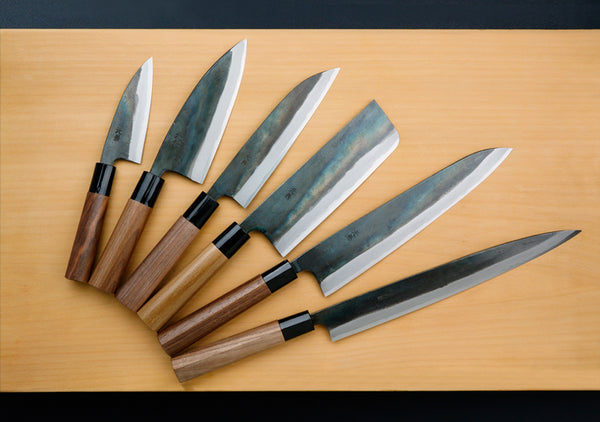"MOTOKANE" Small Knife Kurouchi Aogami Steel 1, Paring 105mm
Sale price
Price
$746.00
Regular price
Unit price
per
★★★ Three HONMAMON Stars
Specification
■ Material:
Blade: Aogami No. 1, Base metal: Soft iron,
Handle: Walnut, Ferrule: Plastic
■ Blade shape: Double-edged
■ Blade finish: Black finish
■ Manufacturing: Made in Japan
■ Uses: For filleting fish and peeling vegetables and fruits
【105mm】
Size:Total length 230mm, Blade length 105mm Blade width 38mm (base) Blade thickness 3mm
Handle length 110mm, Width 23mm (max) Thickness 18mm
Weight: Approx. 65g
Item no. 4582243650236
What is kurouchi knife?

Kurouchi knives retain the scaly residue left from the forging process, meaning that the residue works as coating on the carbon steel to prevent from rust. The finish of Kurouch reduces reactivity on carbon steel knives, and give the knife a very characterful, rustic aesthetic prized by many knife enthusiasts. Kurouchi finishes varying widely in appearance, uniformity, and durability. Rarely do pictures do these finishes justice as they have a very complex look and feel to them. Of course, you need to sharpen the edge every time after using it even if the Kurouchi coating works for the sides of blade.
TOSA traditional skill “Free Forging”

TOSA cutlery started from 1621, over 400 years ago. Forge to finished need many steps, all steps just made from one blacksmith. Easy to control every part and keep it free style to forging, because that’s made by same craftsman. So, that’s why call this skill to “Free Forging”.

With the sound of a violent blow sparks, the way thick steel is transformed into a kitchen knife in the blink of an eye is truly craftsmanship. By hitting it many times with a hammer and stretching it, impurities come out; by making the structure “dense”, it becomes a knife with high hardness and stickiness.

You can see the marks of the hammer that was struck up with a hammer, it has the characteristic of being handmade by craftsmen and resistant to rust compared to polished finishing.

KUROUCHI forging with different color for every cutlery. TOSA “MOTOKANE” with additional process of kurouchi knives. On every knife have different color.
It could have some small scratches, flaws or bent, but they are the proof of handmade! The product seems rougher than machine made ones, but the quality is great, which you cannot feel with machine made one!
This knife isn’t using press process and solvent to make the pattern of knife, The final pattern and color of knife just depend on oxide film by random. So, the one and only knives.
A double-edged sword that can be used in a wide range of genres

One of the defining characteristics of Tosa handmade knives, which trace their origins back to traditional sword smithing, is their double‑edged design.
This makes them more durable and easier to handle than single‑edged knives, ensuring that anyone can use them with confidence.
These versatile knives Japanese for meat fish are ideal not only for preparing meat and fish but also for a wide range of cuisine,
from delicate Japanese dishes to hearty Western cooking. With their balance of strength and usability, Tosa knives stand out as premium knives Japanese for meat fish that combine craftsmanship,
tradition, and modern practicality.
Because free forging, can be easy to innovation.

The knife is consistently performed by a single craftsman, without being bound by the framework of the process, so can continue to improve and evolve.
This knife isn’t mass production. We are focus on the knife quality than productivity. You can feel the soul of craftsman. We recommend you use that for gift.

Features
This Small Knife is fire-forged by one of Tosa's leading knife smiths.
The cutting edge is made of Hitachi Yasugi's high-quality Aogami No. 1 steel.
The thick steel is hammered and stretched by fire-forging to create a dense structure.
Furthermore, the heat treatment is carried out with the utmost care to bring out the best in the characteristics of Aogami No. 1.
This knife is slightly thinner than a Deba knife. Besides filleting small fish,
it is also useful for peeling vegetables and fruits, making it suitable for detailed work.
■ About sharpness:
This knife is made of steel and has been coated with a special varnish for rust prevention.
Using it straight out of the box may result in reduced cutting performance compared to its original sharpness. As you use it,
the varnish will come off, and you will be able to experience the knife's true sharpness through sharpening. Additionally, it has been designed with a versatile edge that can accommodate a wide range of users. It has been finished to make it easy for you to sharpen it to your liking,
so please sharpen it yourself to achieve your preferred cutting performance.
■ Note:
From forging to sharpening, the knife is made by hand.
During the manufacturing process, scratches and peeling of the oxide coating may occur on the blade.
For this reason, we do not inspect for small scratches or peeling of the oxide coating.
Since the knife is free forged, there may be differences in size for each product, and the blade may have slight distortions or bends.
Do not use a dishwasher or dryer.Since it is a steel knife, it will rust.Since it has a black finish, rust is not noticeable, but please wipe off any moisture frequently before use.
Import duties; taxes and charges are not included in the item price or shipping charges. These charges are the buyer's responsibility.




